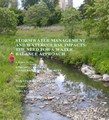Companion Website: Convening for Action community-of-interest promotes 'water-centric' approach to community development
Under the umbrella of the Water Sustainability Action Plan for British Columbia, the Convening for Action Community-of-Interest is the web delivery vehicle for informing British Columbians about the process for moving forward with an array of partnerships that promote a 'water-centric' approach to community planning. Convening for Action is a provincial initiative that supports innovation on-the-ground, and is comprised of three regional pilot programs.
Companion Website: Green Infrastructure community-of-interest promotes 'designing with nature'
Under the umbrella of the Water Sustainability Action Plan for British Columbia, the Green Infrastructure Partnership and the Water Bucket Website Partnership collaborated to develop the Green Infrastructure Community-of-Interest in 2005. The vision for the website is to build capacity through the sharing of experiences, approaches and lessons learned by practitioners in implementing green infrastructure policies and practices that advance the state-of-the-practice in designing with nature.
Rainwater/Stormwater Management: Build a vision, create a legacy is the “Tenth Paradigm”

“Fundamental change in the scope of rainwater/stormwater planning, development standards, construction and operations will only happen if there is a broad understanding as to why the changes are needed, what they are, and how they can be practically implemented,” wrote Erik Karlsen. “Publicly-supported decision-makers will determine the timing and phasing of change. The ability of consumers and the development community to adapt will then set the pace of change. Success in one area will be transferred to others.”
Introducing the Water Balance Model to Ontario

For over half a century Credit Valley Conservation has worked to minimize drought and flooding, improve water quality, support socially and economically viable communities, protect natural features and green spaces, and restore damaged ecosystems. In June 2006, Credit Valley Conservation and the US-based Center for Watershed Protection held an interactive 4-day workshop to provide knowledge-transfer related to experience and lessons learned in other jurisdictions, including British Columbia. Tom Schueler, Center co-founder, praised the British Columbia Guidebook because of its innovation.
Protect Stream Health: Set Achievable, Affordable and Effective Watershed Targets

“Once we went back to basics and developed the concept of a Rainfall Spectrum, this then led into the concept of Performance Targets for rainwater runoff capture. The reason runoff percentage is the performance target is that municipalities exert control over runoff volume through their land development and infrastructure policies, practices and actions,” explained Kim Stephens.
Metro Vancouver Reference Panel raises questions about ISMP process and outcomes to date

“In general, we believe that the plans that are being produced reflect a cookie-cutter approach. The ISMP process has for the most part resulted in drainage planning that applies traditional design criteria and then adds in environmental requirements. This Old Business As Usual approach has the result of increasing unfunded budget items/liabilities without resulting in a benefit,” reported Kim Stephens.
Stormwater Management and Watercourse Impacts: The Need for a Water Balance Approach

The report emphasizes that progressive jurisdictions are developing water balance approaches to rainwater/stormwater management for urban development to mitigate the geomorphic and biotic impacts that result from current practice. Such approaches utilize best management practices to infiltrate or evaporate water and minimize increases in runoff volume.
Water Balance Model Attracts World-Wide Audience!
The missing link in watershed planning has been a tool that quantifies the benefits – in terms of reducing rainwater runoff volume – of installing source controls under different land use, soil and climate conditions. The Water Balance Model for Canada provides the foundation for a natural systems approach to rainwater anagement. Furthermore, it promotes integration of perspectives that leads to better decision making, and can be applied at three scales: site, subdivision and watershed.
District of Central Saanich is newest Vancouver Island member of Water Balance Model community (July 2008)

The Central Saanich Integrated Stormwater Management Plan recommends that the Water Balance Model be used as a tool in development site design. “The District of Central Saanich is distinguished as the first municipality on Vancouver Island to commission an ISMP pursuant to the guidelines and recommendations in Stormwater Planning: A Guidebook for British Columbia,” stated Nirmal Bhattacharya
Rain Gardens Reign in Kansas CIty, Missouri
Rain gardens may have started in Maryland and been developed in Maplewood and Burnsville, MN, but it was Kansas City, MO, that put them on the map of public awareness. The City has implemented a program which has a goal of 10,000 rain gardens by 2010.

